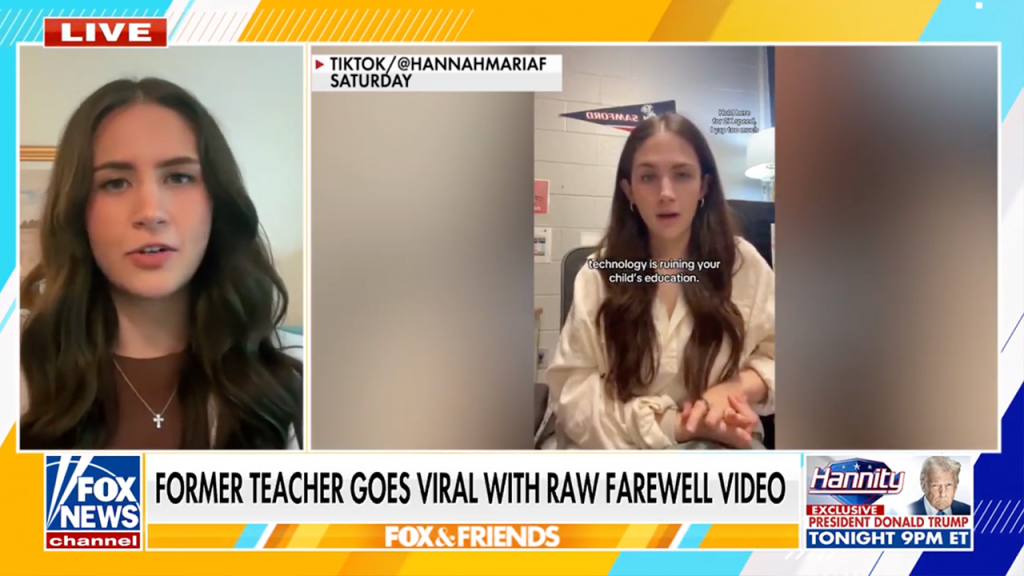A former high school English teacher has made headlines this week by announcing her resignation in a heartfelt yet critical social media rant, where she expressed her concerns about the impact of artificial intelligence on education. Her candid video has sparked widespread discussion about the role of technology in academic environments and the future of teaching as an essential profession. As educators grapple with the integration of AI, her story highlights a growing sentiment among teaching professionals regarding the pressures and changes brought on by evolving technologies.
| Article Subheadings |
|---|
| 1) Teacher’s Viral Announcement Sparks Debate |
| 2) The Role of AI in Education |
| 3) Reactions from the Education Community |
| 4) Implications for Future Educators |
| 5) Conclusion: The Future of Education amidst AI |
Teacher’s Viral Announcement Sparks Debate
The announcement made by the former high school English teacher has resonated with many educators and parents alike. In her video, which quickly went viral, she expressed her deep frustration over how artificial intelligence is “ruining” education. According to her, this technology is not just a tool; it’s a disruption that is undermining the time-honored teacher-student dynamic. She cited several occasions where she observed students opting for AI-generated assignments instead of engaging in creative writing exercises, leading to a loss of critical thinking skills. The timing of her resignation, which coincides with a noticeable rise in AI tools used in classrooms, has fueled a debate around the relevance of teachers in an increasingly digital learning landscape.
The Role of AI in Education
Artificial intelligence has gradually found its way into various aspects of education, from personalized learning to administrative tasks. Proponents argue that AI can provide tailored learning experiences for students, helping them grasp concepts at their own pace. However, critics, including the teacher who resigned, warn that this technology fosters a culture of dependency rather than empowering students to think independently. They raise concerns over the authenticity of AI-generated content, fearing it may lead to diminished writing skills and creativity among students. With schools rapidly incorporating this technology, the challenge lies in striking a balance between leveraging AI’s potential advantages while preserving the educational values that come from traditional teaching methods.
Reactions from the Education Community
Reactions to the teacher’s resignation have been mixed within the education community. Some educators have expressed solidarity with her decision, sharing similar feelings about the challenges posed by AI. They cite a phenomena where students, overwhelmed with quick information access, often lose motivation to engage in deep learning processes. Other educators, however, have voiced their belief in the potential of AI as a supplemental tool rather than a replacement for teachers. They argue that integrating AI allows for more efficient use of classroom time, enabling educators to focus on nuanced discussions and interactive learning experiences, thereby enriching the learning environment.
Implications for Future Educators
The resignation of this teacher underscores the growing unease among current and future educators regarding the integration of technology into the classroom. Future educators may feel pressured to adapt quickly to an ever-changing educational landscape dominated by AI. Many institutions are grappling with this transition, and as a result, they might revise their teacher training programs to include comprehensive courses on digital literacy and technology integration. Educational leaders must find ways to prepare teachers for the challenges posed by AI while also reinstating the importance of the human element in education to foster a healthy learning environment.
Conclusion: The Future of Education amidst AI
The turmoil sparked by one teacher’s viral resignation is emblematic of a broader conversation about the future of education. As classrooms evolve with the introduction of artificial intelligence, the dilemma becomes more pronounced: how to harness the full potential of technology while retaining the intrinsic value that educators bring to student development. The complex relationship between teachers and technology will require ongoing dialogue and thoughtful solutions. It is essential that educators, policymakers, and technology developers collaborate to ensure that students receive a well-rounded education that prioritizes both innovation and personal interaction.
| No. | Key Points |
|---|---|
| 1 | A former high school teacher announced her resignation, citing AI’s detrimental effects on education. |
| 2 | The video she shared resonated widely, igniting discussions about the role of technology in schools. |
| 3 | Supporters and critics within the education community are divided on the integration of AI. |
| 4 | The events have spurred calls for updates to teacher training programs focusing on technology use. |
| 5 | Dialogue between educators and policymakers is crucial for a balanced approach to technology in education. |
Summary
The viral resignation of a teacher over her concerns about artificial intelligence highlights significant issues surrounding technology’s place in education. As discussions about AI’s impact continue, it is vital to find constructive ways to incorporate technology without sacrificing the essential human elements of teaching. The future of education must navigate these challenges with a focus on maintaining rigorous learning standards while embracing innovations that enhance the educational experience.
Frequently Asked Questions
Question: Why did the teacher resign?
The teacher resigned due to her belief that artificial intelligence is significantly undermining the quality of education and the student-teacher dynamic.
Question: What concerns do educators have about AI in education?
Educators are concerned that AI may hinder critical thinking skills and creativity among students, encouraging dependency on technology for assignments.
Question: How can schools balance AI technology with traditional teaching methods?
Schools can balance AI with traditional methods by using technology as a supplement while ensuring that human interaction and critical thinking remain central to the learning process.
